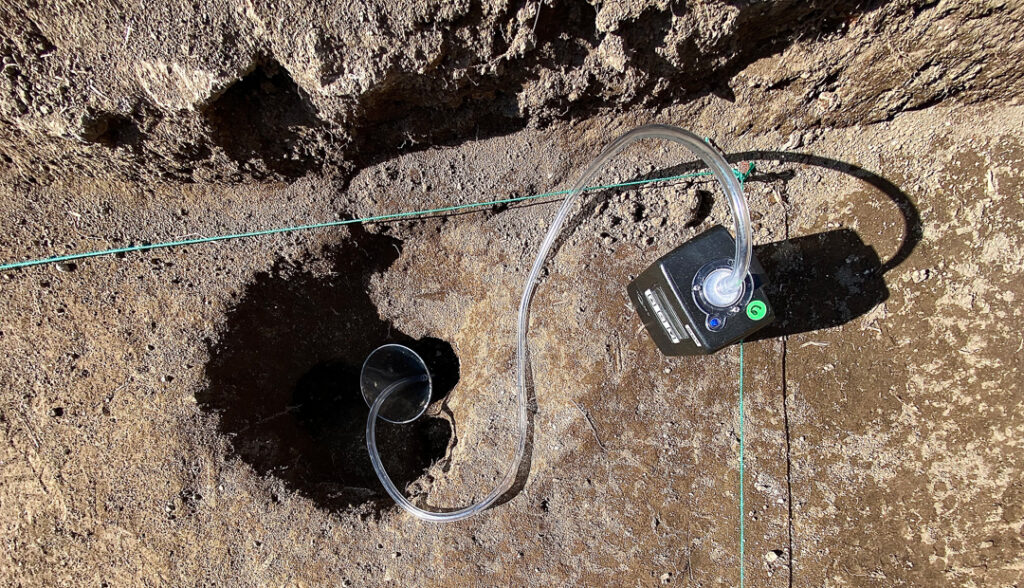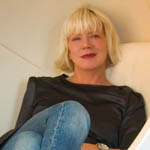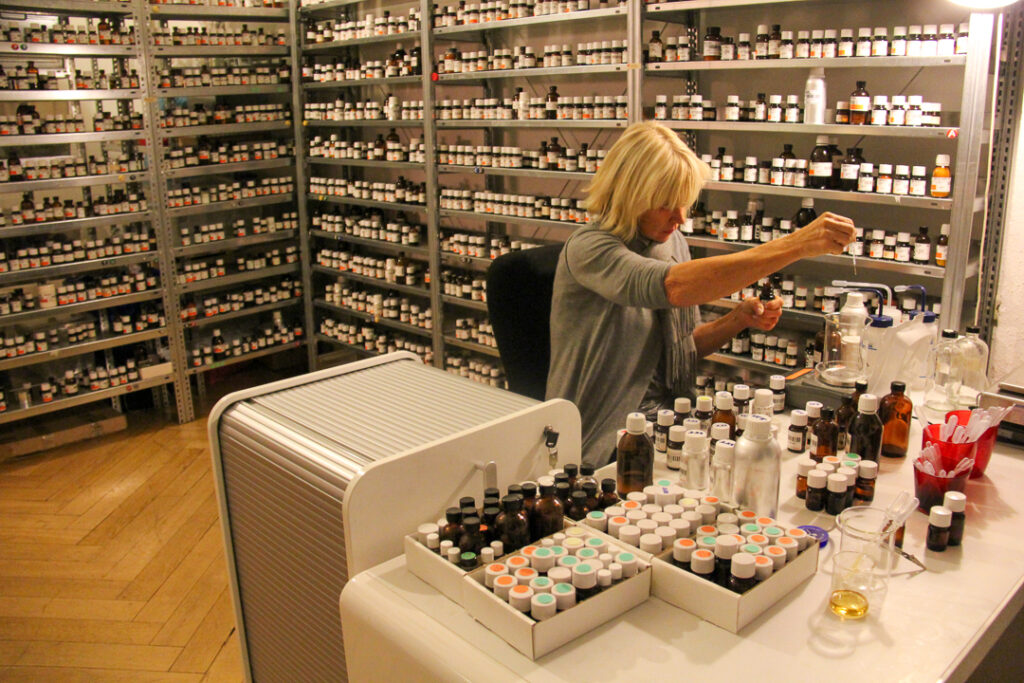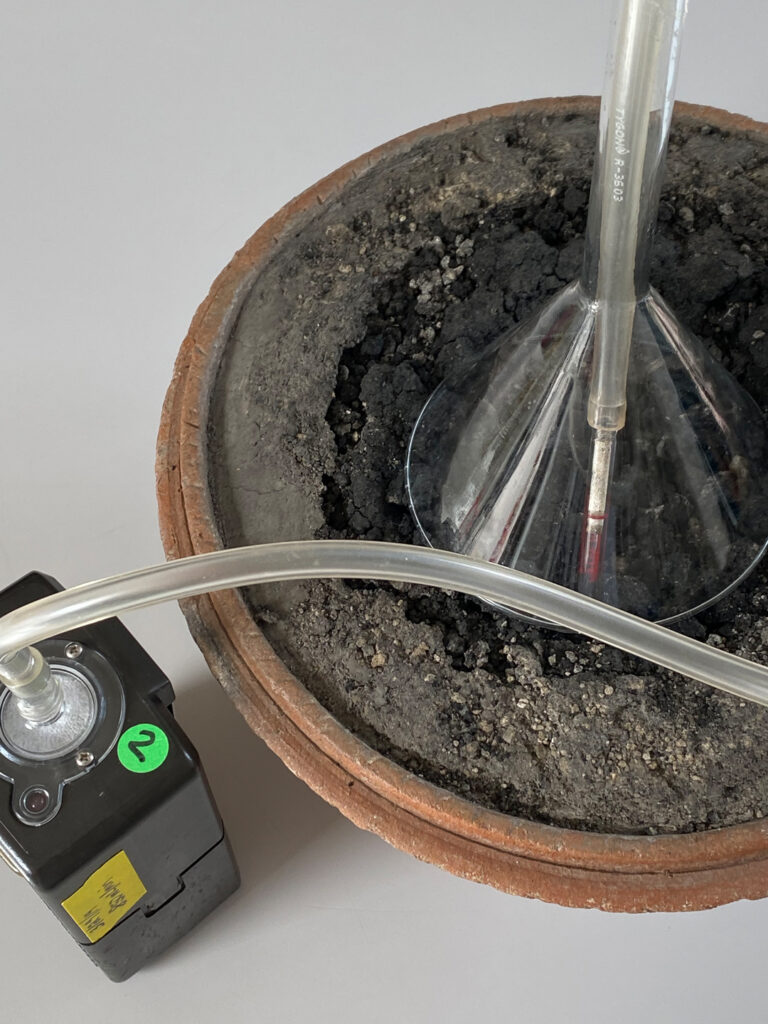
Documentation of the molecular sampling activity carried out by Sissel Tolaas in situ at the Archaeological Park of Pompeii, February/September 2022; courtesy the artist, Nicoletta Fiorucci Foundation, Ministero della Cultura and the Archaeological Park of Pompeii, in the context of Pompeii Commitment. Archaeological Matters; photo: Sissel Tolaas
Sissel Tolaas has developed archeological tools for discovering the smells of Pompei, which promises to connect us emotionally to the ancient past.
Following my nose
Over the past twenty-five years, I have dedicated myself to honing my olfactory sense into a highly sophisticated tool. At times, I find myself contemplating that the human nose may be more sophisticated and advanced than any technological device available for recording volatile molecules emitted from a source of smell.
I am grateful for the opportunity to shed light on the intricate and abstract process of sampling and recording imperceptible and intangible information. The world around us is teeming with life: past, present and future. Wherever there is air, we find a plethora of smell molecules. Notably, in the context of an archaeological site, these smell molecules are ubiquitous and deeply embedded on both micro and macro levels.
My journey begins at the archeological site, armed with my most advanced interface, the nose. Through its remarkable capabilities, we can discern and identify an astounding number of molecules, potentially reaching up to a trillion. While other instruments and technologies can aid in recording core molecules within the environment, the human nose remains indispensable in determining what and where to focus the molecule recordings, as well as in making sense of the resulting data.
My process involves being in the field independently while engaging in dialogue with various experts present at the location, such as archaeologists, anthropologists, biologists, geologists, psychologists, and others. Preliminary conversations before any excavation are of paramount importance, ensuring that everyone involved comprehends the objectives of my recordings and how the ultimate outcome can benefit all parties.
The process itself, along with my active presence during fieldwork, is just as crucial as the data outcome. My expertise in organic chemistry, neuroscience, biology, and related fields, coupled with a shared enthusiasm and compassion for the subject matter, are all essential elements for achieving success in this endeavour.
In general, I have been utilising my nose to gain a new understanding of the world, placing greater emphasis on it over relying solely on my eyes. Exploring how our senses can work both individually and harmoniously is captivating, fostering cooperation and coherence in our perception of the world.
Olfactory archaeology
In the fields of archaeology and understanding smell, there is a curious point where progress seems to have stagnated or become stagnant. It was at a particular moment in history that I embarked on my exploration of the sense of smell, a time when its understanding was confined within a metaphorical hermetic box. I found myself immersed in a knowledge framework that provided comfort for those who sought to conceal the unknown aspects of the world. However, even then, my approach was driven by a burning question: “Can I contribute to uncovering the world before it becomes masked by unrelated smells that hide its true essence?” This question still drives my process today, as I endeavour to utilize the knowledge of smell to assist in recognizing and appreciating our shared reality.
SMELL is AIR is a collective endeavour. My goal is to encourage a deeper appreciation for this aspect of our existence. To venture into comprehending other forms of communication, such as chemical communication, we must embrace curiosity and be willing to step beyond our comfort zones.
In the process of excavation, archaeologists primarily focus on tangible remains like bones, stones, ceramics, and glass. But what if we also cultivated an awareness of the olfactory experience while uncovering layers of soil and dust? As the different layers are exposed, the air itself changes, and I take pride in recording the very air that we all breathe. By acknowledging the significance of all senses, including smell, and the joy they add to understanding, the archaeological site becomes a sensory playground.
In science, it is essential not to let emotions cloud judgment. However, in this process, emotions play a vital role. Expressing emotions during this journey is encouraged. When we write protocols, we can adopt a hardcore, rational, and pragmatic approach, as is customary in scientific endeavours. Yet, as an artist and scientist, I also possess the freedom to emphasize specific aspects of the data for storytelling purposes.
My process is a homage to memory, utilizing smell as a catalyst to activate it and provoke questions about the past, present, and future of memory. Differentiating between collective and individual memory becomes pertinent, and here, the olfactory sense proves remarkably intelligent, stimulating both memory and emotions without the interference of rationality.
My protocol is multi-layered, exploring the link between reaction and action, insights into chemistry, memory measurement, and recall of subconscious data. Despite its complexity, the scientific aspect remains integral to the process, as I strive to unravel the mysteries of smell and its profound influence on our understanding of the world.
Using smell as a research tool, we have come to realize that our nose is more than just a physical part of our body; it is also an instrument for intellectual understanding. Our process starts with chemical data, but it delves deeper, opening up the possibility of telling stories connected to this data. In the world of archaeology, artists may be seen as an alien interference, but they also reveal something essential: archaeologists, like artists, must use their imaginations to “fill the gaps” and face what they do not yet understand.
Pompeii
- View of Pompeii, September 2022 Courtesy the Artist, Nicoletta Fiorucci Foundation, Ministero della Cultura and the Archaeological Park of Pompeii, in the context of Pompeii Commitment. Archaeological Matters; photo: Sissel Tolaas
In the history of the Western Grand Tour, every artist, scientist, or writer who visited Pompeii acknowledged the unique connection they felt with the past as if they were contemporaries of the ancient civilization. In my case, with the psychological and sensorial power of smell, this connection becomes even stronger, contributing to the ongoing history of the Grand Tour that shaped Pompeii into a constantly recreated and reinvented platform.
In today’s world, dominated by artificial intelligence and virtual reality, it is essential to recognise the significance of engaging all our senses to comprehend the pressing issues we face. Failing to do so may render our senses obsolete long before the ruins of Pompeii fade away. Emotions play a crucial role in driving progress and adaptation, even in the evolution of biology. By embracing a holistic approach that encompasses our senses and emotions, we can navigate the complexities of our changing world and gain a deeper understanding of our surroundings.
In Pompeii, I initially faced scepticism about my role, but upon introducing myself, I quickly became an integral part of a collective endeavour. The conversations I engaged in during fieldwork were just as significant as the data I recorded from diverse excavations, becoming an integral part of the archives I am building up.
The awe-inspiring experience of being in the field transformed our project into something profoundly holistic. Recording smell molecules on the spot alongside the excavation process opened up new possibilities for understanding Pompeii as a site encompassing sensory dimensions. With various mobile instruments such as mobile headspace, I am able to collect volatiles: smell molecules that emit from the soil and dust during excavation. This has to happen extremely close to that action of digging: literally simultaneously with the digging. The volatiles get collected into a glass tube: a tenax. I compare the dynamic headspace concentration on tenax with solid phase microextraction for the analysis of volatiles.
- Documentation of the molecular sampling activity carried out by Sissel Tolaas in situ at the Archaeological Park of Pompeii, February/September 2022 Courtesy the Artist, Nicoletta Fiorucci Foundation, Ministero della Cultura and the Archaeological Park of Pompeii, in the context of Pompeii Commitment. Archaeological Matters; photo: Sissel Tolaas
The tenaxes were then analysed with gas chromatography. The data required is the starting point for the identification of the individual molecules and further investigation into their origin. These molecules provide new types of information to the context of concern.
I aim to challenge the status quo, encouraging a shift in perspective regarding what was once considered inflexible. By letting people in the field, including guides and visitors, tell and alter their stories while observing our work, we unlock diverse narratives and potential.
My presence brought forth a thought-provoking and evocative dimension to the site. By engaging in recording activities of smell molecules emitted from the soil, we gained a new perspective on Pompeii, not just as a static place, but as a site with living sensory dimensions.
While adjusting to pressing global issues, I remain an individual operating within the framework of humanity, interpreting and communicating my discoveries in unique ways.
By creating an archive of conversations and experiences, I hope to endure the significance of these interactions. The data we collect will breathe life back into the ruins, sharing authentic smells and their stories. In this process, we explore different forms of information and communication, challenging established methods, and broadening horizons.
This endeavour is tangible, offering new avenues and access to context, content, and knowledge previously unexplored. Smell molecules are a fundamental reality, existing wherever life has been present. As we delve into the microscopic level, we navigate through multiple realities, intertwining various elements.
The heightened appreciation of our senses during COVID-19 highlights the importance of interfaces and sensors. This is an opportune moment to conduct research in this field, recognizing the significance of sensory experiences.
The ephemeral nature of smell prompts us to label this project a “smell heritage archive.” Smells exist for an instant and then vanish, blending with the environment. Despite their fleeting nature, they hold remarkable and profound significance.
Emotional history
Observing human development from infancy to puberty, we realise that emotions play a central role in our learning process during this period. However, as we grow older, the rational part of our brain becomes dominant, leading to a disconnection from the holistic understanding we once had. Reintegrating our senses and emotions into our approach to learning and understanding can help us regain a comprehensive perspective and make sense of the overwhelming flood of information in the information age.
Engaging with the past through emotions, particularly through the sense of smell, can be a powerful catalyst for action. Smells have the ability to evoke memories, joy, and playfulness, connecting us with historical experiences and civilizations. By tapping into the sensory experiences of the past, like those at Pompeii, we can gain insights into ancient ways of life, such as waste management, which can inform our present actions and future endeavours.
Creating archives that capture the olfactory aspects of historical sites enables us to bridge the gap between different time periods and civilizations. These archives facilitate dialogue that transcends temporal boundaries, providing valuable resources for learning from the past and shaping a better future for our own civilization. Exploring smells in historical contexts reveals new layers of knowledge and establishes transcendent processes and archives that build bridges across time.
By leveraging the power of smell, we open up avenues for a deeper connection with history, enabling us to learn from the past, develop innovative solutions, and focus on creating a sustainable future. As we continue to explore the potential of smell and its role in understanding historical sites like Pompeii, we unlock the transformative power of emotions and sensory experiences to shape our collective journey into the future.
INVISIBLE POMPEII: POMPEII SMELL HERITAGE ARCHIVE 79AD_2079 by artist and smell researcher Sissel Tolaas is an ongoing investigation into the possibilities of olfactory heritage, conceived and commissioned in 2020 by the Nicoletta Fiorucci Foundation, Team Partner of the Pompeii Commitment. Archaeological Matters at the Archaeological Park of Pompeii, where Tolaas is a Digital Fellow.
About Sissel Tolaas
 Professional in_betweener: where there is air there is life there are smell molecules there is Sissel. I have been working, researching and experimenting intensively with the topic of smell since 1990. I have developed a wide range of revolutionary interdisciplinary projects worldwide with smells based on my knowledge – forensic chemistry, chemical communication, sensory ecology, linguistics, and art. My SMELL RE_searchLab (chemistry lab) has a collection of smell molecules and smell structures from 1990 and ongoing including 20K smell molecule recording samples and formulas. I am currently working on several types of smell archives such as Smell & Communication/ language; Smell & Coding; Smell & Anthropocene; Smell & Extinction; Smell & Sensory Ecology; Functional Smell Molecules; smell-molecule preservation /conservation archives on the World’s Oceans, World’s Forests, and smell ecofacts / artefacts, and smell heritage archive for the Pompeii Ruins; Bahrain Pearling Past for and with UNESCO. Follow @sssl_berlin
Professional in_betweener: where there is air there is life there are smell molecules there is Sissel. I have been working, researching and experimenting intensively with the topic of smell since 1990. I have developed a wide range of revolutionary interdisciplinary projects worldwide with smells based on my knowledge – forensic chemistry, chemical communication, sensory ecology, linguistics, and art. My SMELL RE_searchLab (chemistry lab) has a collection of smell molecules and smell structures from 1990 and ongoing including 20K smell molecule recording samples and formulas. I am currently working on several types of smell archives such as Smell & Communication/ language; Smell & Coding; Smell & Anthropocene; Smell & Extinction; Smell & Sensory Ecology; Functional Smell Molecules; smell-molecule preservation /conservation archives on the World’s Oceans, World’s Forests, and smell ecofacts / artefacts, and smell heritage archive for the Pompeii Ruins; Bahrain Pearling Past for and with UNESCO. Follow @sssl_berlin








